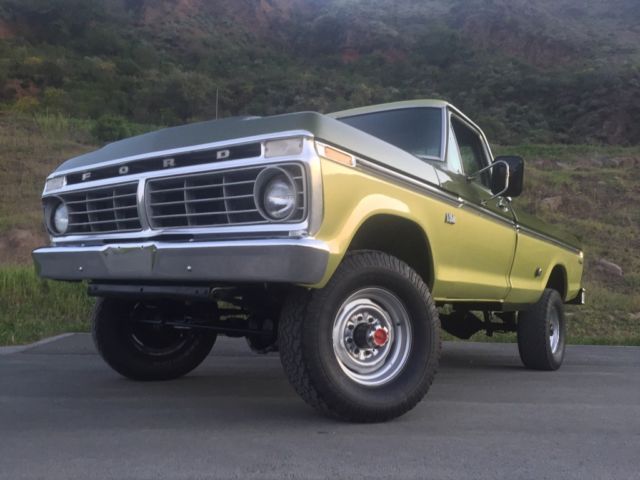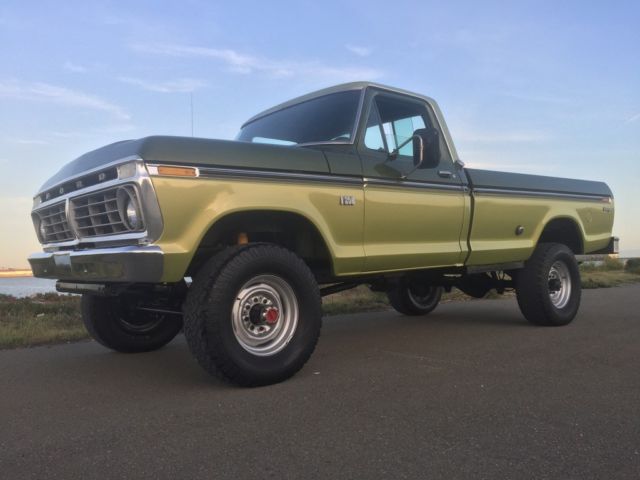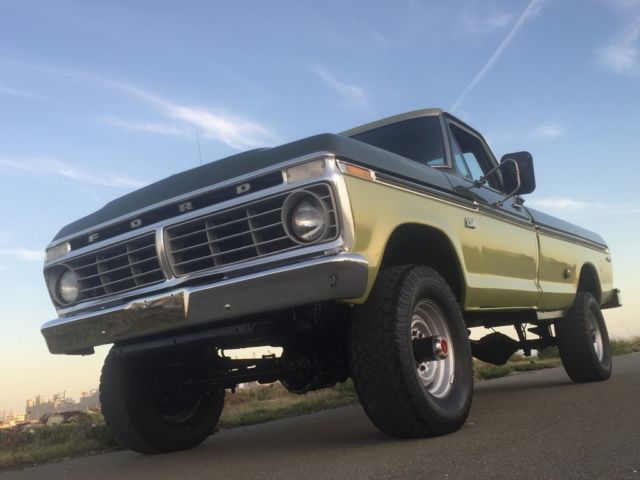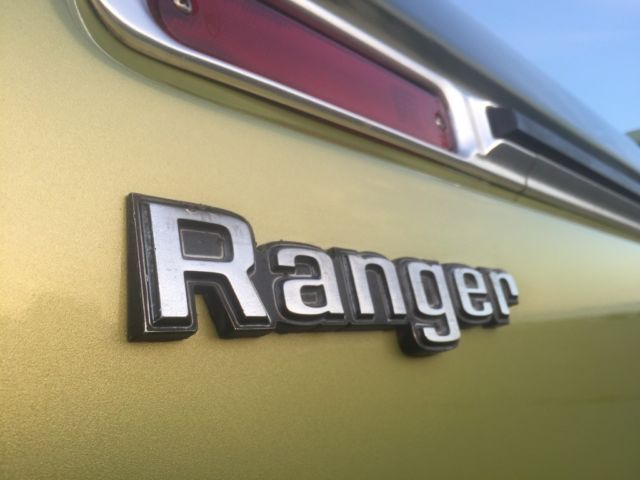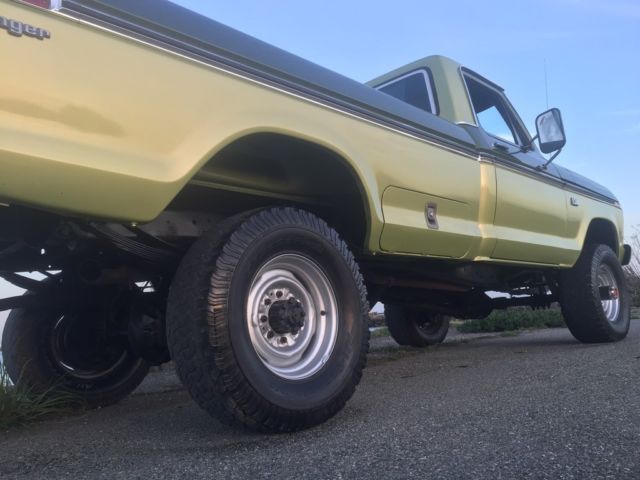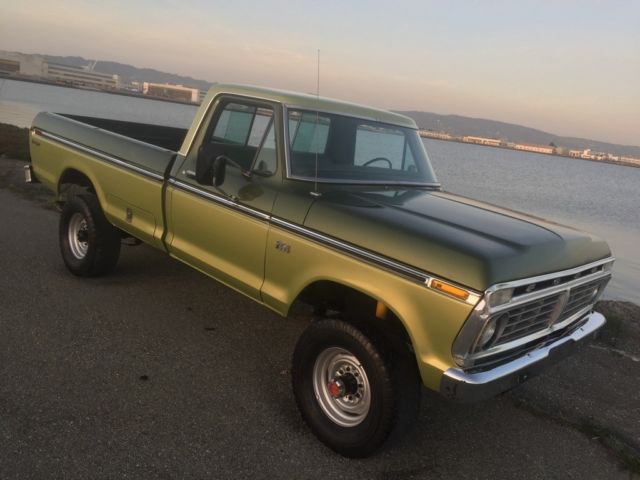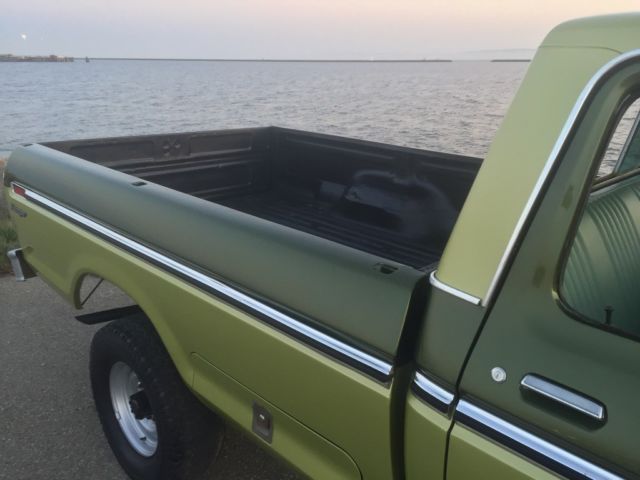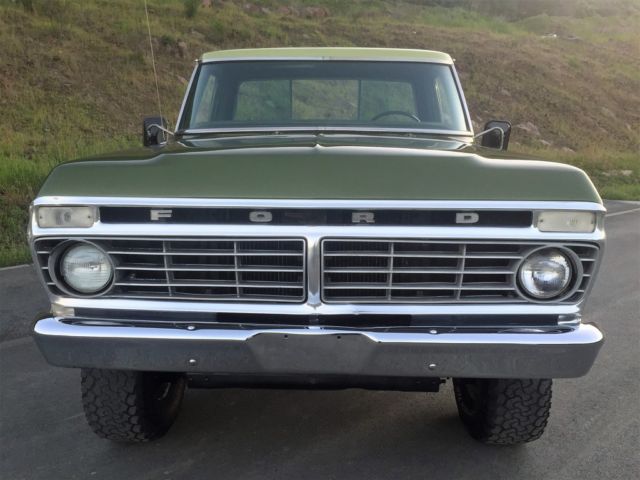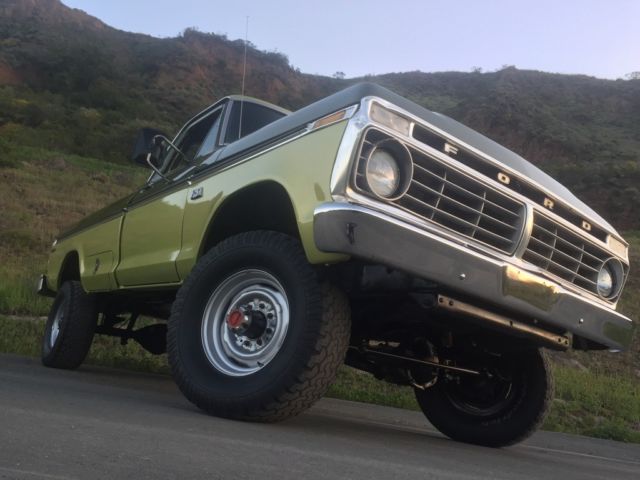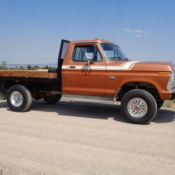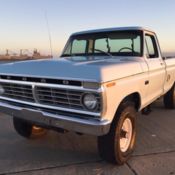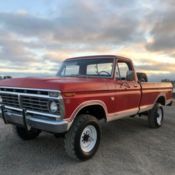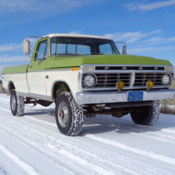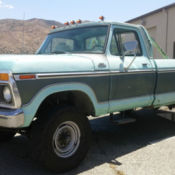1975 Ford F250 Highboy 4wd Very Rare "DSO-code" California Barn Find No Reserve
| Make: | Ford |
| Model: | F-250 |
| Type: | Standard Cab Pickup |
| Trim: | Ranger |
| Year: | 1975 |
| Mileage: | 123,456 |
| VIN: | F26YRX02812 |
| Color: | Med Green Glow Glamour/Hatteras Green Metallic |
| Engine: | 360 |
| Cylinders: | 8 |
| Fuel: | Gasoline |
| Transmission: | Manual |
| Drive type: | 4WD |
| Interior color: | Green |
| Drive side: | Left-hand drive |
| Vehicle Title: | Clear |
| Item location: | Oakland, California, United States |
| Extras |
|
4-Wheel Drive |
| Listed by | Private seller |
Description of 1975 Ford F-250 Ranger |
|
|
1975 FORD F-250 4-WHEEL DRIVE "HIGHBOY" RANGER VERY RARE "DSO CODE" (DISTRICT SALES OFFICE) SPECIAL FACTORY ORDERED GLAMOUR GLOW PAINT "California Barn Find" ~Very Rare #F-26 4x4 Ranger ~ Special factory ordered built in San Jose California ~Lifelong California Resident Medium Green Glow Glamour over Hatteras Green Metallic ~Sold 43 years ago in Lafayette California ~Copy of Original MSRP ~Once in a lifetime time capsule that cannot be duplicated NO RESERVE AUCTION BID TO WIN Up for bid is a unique opportunity to buy an original 1975 Ford F250 4 wheel drive 3/4 ton pickup Highboy pickup that would be nearly impossible to duplicate and is possibly a one of a kind. MSRP F262 133 CUSTOM STYLESIDE PICKUP WITH 4X4 OPTION MED GREEN GLOW GLAMOUR PAINT WITH HATTERAS GREEN METALLIC REGULAR AND DELUXE TUTONE 7700 GVW PACKAGE ENGINE 360 V8 RANGER PACKAGE AMMETER - OIL GUAGE AND FUEL ECOM LT EMISSIONS SYSTEM-CONTROL PKG TOOL STORAGE BOX AXLE RR 5300 DANA 60 LIMITED SLIP POWER STEERING AXLE FR 3550 DANA 6CF-HD LH-RH SWING MIRRORS RADIO AM SLIDING REAR WINDOW REDUCED SOUND LEVEL EXHAUST SUPER COOLING PACKAGE VIN: F26 Y R XO2812 F26= 1973-1979 4WHEEL DRIVE F250 Y= 360 V8 R= SAN JOSE CALIFORNIA X02812= SEQUENTIAL PRODUCTION NUMBER 5/75 BUILT WB = 133 A= NEW PROCESS 435 MANUAL 4 SPEED F-262= 73-79 F250 4 WD PU AXLE= #B4P B4= 4.10 DANA 9SPICER) MODEL 60 LIMITED SLIP P=4.55 RATIO DANA SPICER MODEL 60F WITH POWER STEERING In the collector car market value is all about supply and demand and rare vehicles that were built in limited supply are rare because fewer were built. Vintage 4 wheel drive classics were limited to a need basis were conditions required 4wd for snow and ice or an overall harsher enviromenthowever places like sunny California 43 years ago people simply did not buy 4x4 trucks as they do today where a 4x4 truck is the norm the best example of supply affecting demand for vintage 4x4s are the 1966-1977 Ford Broncos or the old Toyota FJ40s which have skyrocketed in value in the last few years. The demand has gone up as the supply has dwindled. People in places like Wyoming or Michigan bought them for a purpose and over time used them up. The next collector boom is going to be vintage 4x4 trucks accordingto Fortune magazineand Hagerty Insurance the largest collector car Insurance company in the nation who has a vested interest in collector car trends and have said the 1973-1979 Ford F series trucks are on the way up the most valuable being the more limited production 4x4 models. They made a lot of Ford F series trucks in those years and has been the number one selling vehicle in the country for decades however the majority being the 2 wheel drive model 1/2 tons which account for about 82% of the F series sales in comparisonthe much heavier duty F-250 3/4 tons were sold as work trucks and fewer were built with only 18% of the F-series production being 4x4s and in 1975 when increased fuel cost was an issue for all auto sales in America the majority of heavy duty 4 wheel drive trucks were sold by dealers for use in areas where 4WD was needed for snow and rough terrain and even though many were built in California for the entireWestern region most were shipped to places like Montana or Idaho and 4 decades plus later most of those were used up and are long gone or riddled with rust from exposure to salted roads and years of heavy duty use. This 1975 Ranger "Highboy" is a true California survivor having been a loaded up special ordered "DSO Code" direct from the (District Sales office #72) at the San Jose California factory from Don Young Ford in Lafayette California just 30 miles to the North. The one thing for sure few Highboys were made like this Ranger and common sense would dictateeven fewer 4 decades later stillexist (Other special order vehicles that were DSO codes built in San Jose same are the original Mustangs Fastbacks that were shipped from San Jose south to the Shelby factory at LAX in Southern California) This dealership in Lafayette was a small low volume Ford dealership in a upscale community 20 min east of San Francisco. The 1970's was an era where small dealerships in expensive areas relied on high profit items to offset the lower sales volumes (and this was about as expensive of a pickup that was available at the time) and in 1975 when many people were shifting to more fuel efficientimport vehicles it would not be uncommon to see a top of the line Mustang convertible in a rare color like medium green glamour glow or yellow green metallic but quite unusual for a heavy duty truck which was designed to bring the people in by having something special or unusual on the show room floor. Ironically this truck never made to the showroom and was dealer traded to a dealer across the bay in Burlingame California and has spent the last 43 years in one of the most expensive zip codes in the Golden State Hillsborough California at the time home to people like Bing Crosby and Shirley Temple Black not a typical demographic in 1975 for a 3/4 ton 4 wheel drive pickup. It was built and sold in the San Francisco Bay Area and has never left. This is a once in a lifetime opportunity that you or I can not duplicate This is possibly one of a kind 1975 Ford F250 4x4 Ranger "Highboy" - YouTube Video will open in a new window What is a "Highboy" Highboy: 1967-1977.5 Ford F-250 4x4 Regular Cab or Crew Cab light-duty ################################################## ######################### Highboys came with tall, thin tires with an off-road tread. Many people put larger tires on. A stock Highboy with its suspension in good condition can handle 37-inch tall tires, as long as the tires are fairly narrow, such as 12.5-inches wide, and the wheels have appropriate back-spacing. Some people have managed 38-inch tall tires, although usually, this is the point where suspension or body lift is required. Highboy wheels were 8.00x16.5 inches, and are often replaced with 16-inch wheels. ################################################## ######################### # Highboy Transfer Cases # ################################################## ######################### All Highboys had divorced transfer cases, as opposed to married transfer cases. A married transfer case is bolted directly to the transmission. A divorced transfer case is bolted onto its own cross-member, and is separated from the transmission by a driveshaft. Highboys had Dana 24 part-time transfer cases from 1967-1973, and either the standard NP205 part-time or optional NP203 full-time transfer cases from 1973-1977.5. The NP205 is the strongest and most desirable factory transfer case. The Dana 24 is a cast-iron, gear-driven, part-time, 2-speed case with 1.86:1 gears. The NP203 is a chain-driven, full-time, 2-speed case with 2.00:1 gears. The NP205 is a cast-iron, gear-driven, part-time, 2-speed case with 1.96:1 gears. ################################################## ######################### # Highboy Transmissions # ################################################## ######################### Highboys had either a 3-speed Ford Toploader manual (1967-1971), the NP-435 4x2 4-speed manual (1967-1977.5 -- yes, the 4x4 got the 4x2 transmission), or the optional SelectShift Cruise-O-Matic C-6 in 1973-1977.5. The reason that 4x2 transmissions were used in these 4x4's was due to the divorced transfer case. The NP-435 was optional in 1967-1971, and standard in 1972-1977.5. Toploader Models (Engines): RAN-E1 (240 1V), RAN-G1 (240 1V), RAT-G (300 1V, 360 2V), RAT-H (300 1V, 360 2V) Toploader Gear Ratios (1,2,3,R): 2.99, 1.75, 1.00, 3.17 NP-435 Gear Ratios: (1,2,3,4,R): 6.69, 3.34, 1.79, 1.00, 8.00 Cruise-O-Matic Gear Ratios: (1,2,3,R): 2.46, 1.46, 1.00, 2.20 ################################################## ######################### # Highboy VIN # ################################################## ######################### An example Highboy VIN is F26YRTxxxxx. F26 designates a F-250 4x4. All Highboys begin with F26. The 'Y' indicates a 360 2V V-8 engine (1968-1976), although other engines were offered, such as the 240 1V Six (1967-1972), 300 1V Six (1967-1977.5), 351M 2V V-8 (1977), 352 2V V-8 (1967), and 400 2V V-8 (1977). ################################################## ######################### # Highboy Wheelbase # ################################################## ######################### The Highboy Regular Cab wheelbase changed from 131 inches in the fifth generation (1967-1972) to 133 inches in the sixth generation (1973-1979) F-series, and the Highboy Crew Cab was 150 inches in 1973-1979. ################################################## ######################### # Lowboy # ################################################## ######################### All F-250 4x4's after 1977.5 (specifically, beginning in March 1977) are considered "Lowboys". Lowboys continued with the NP203 transfer case, and could also have the NP205 transfer case, although from 1977.5-1979 it was a married transfer case. Due to the married transfer case on the Lowboy, the rear did not need the 4-inch lift block to match the front height. The Lowboy used the wider F-250 frame, having 37.5-inch wide frame rails. The Highboy Regular Cab frame is 28.8% stronger than the Lowboy Regular Cab frame, and the Highboy Crew Cab frame is 9.8% stronger than the Lowboy Crew Cab frame. The Lowboy's wider rear frame gave greater stability, allowed the gas tank to be mounted under the bed, and makes it easier to swap beds (since most beds are non-Highboy beds, and the two types of beds do not interchange). Other Lowboy improvements over 1977 Highboys were optional high-pinion front Dana 60's (such as in the Sno-Fighter), optional integrated power steering, and 3-inch wide rear leaf springs. From 4Wheeler magazine the era of the highboy truck was over and Ford was the last holdout. “Highboy” describes the stance, but the reason for that stance isn’t clear to everyone. A true highboy has a divorced transfer case, meaning it is separate and connected to the transmission via a short driveshaft, rather than being married to the back of the transmission as is common today. Among other things, that divorced layout necessitates a very long front driveshaft and, for clearance, the ride height of the truck must be higher. In the early days of 4x4 pickups, virtually all were in the highboy club because the first 4x4 pickups were conversions of a 4x2 chassis. It was simpler and cheaper to utilize the original 4x2 transmission than to design an adapter to marry them. Those first highboys were even higher than later trucks because there were often clearance issues between the front axle, driveshaft and the engine. The end result was a much higher cargo loading height versus that of a 4x2, more entry/egress effort for the human cargo and a higher center of gravity. This is one reason why the Camper Special option was nonexistent for highboys because they didn’t want to encourage their use with a super-high center-of-gravity truck. Starting in the late ’60s, a conscious effort was made to lower the stance of 4x4 pickups. Jeep started the ball rolling with the intro of the ’63 Gladiator line. Those trucks were notably lower than the competition and that was a pretty big selling point. GM got on the same bandwagon with the ’67 models. Dodge was fully lowboy by 1975, and International Harvester had not changed over by the time the light trucks were discontinued in 1975. Ford was the holdout and wasn’t fully changed over until the beginning of 1977 (some sources say the end of Ford highboy production was February, 1977). The ’70s-era Ford F-100 or ’76-and-up F-150 do not qualify as highboys because they had married transfer cases and a much lower ride height. Ford had a limited presence in the 4x4 pickup market through 1973, with only a couple of models available. By 1976, the company was set to explode upon the market. Ford had short and long wheelbase F-100 4x4s, an F-150 4x4 (which was basically positioned as a higher GVW ½-ton) and theF-250. There were noF-350 4x4soffered until 1980. For 1976, your outfitting choices for an F-250 4x4 were pretty narrow compared to the 4x2s. The base engine was the 300ci inline-six, which was offered only with the NP435 manual trans, part-time NP205 transfer case and 4.10:1 axle ratios. The only engine option was the 360ci two-barrel V-8. That was frustrating because the 4x2s were also offered with an optional 390 four-barrel (190hp) or the new 460 four-barrel (230hp), both of which were substantially more powerful than the 145hp 360, in addition to the 300 Six or the 360. If you opted for the 360, it came standard with the NP435, but you could order the C6 “Cruise-o-Matic” automatic. Also optional, only with the automatic and V-8, was the NP203 full-time four-wheel-drive system, which had been available since 1973. It used a divorced version of the NP203 full-timer and was noted for driveshaft vibration. Axles were the low-pinion Dana 44 up front and a full-float Dana 60 in back. A Dana Powr-Lok was optional in the rear. The ’76 Ford Data Book says that only a 4.10:1 ratio was available in all F-250 4x4s but some sources list 3.73:1 as well. Functional options not previously mentioned included power steering (which was an old-style ram-type on the tie rod versus the more modern integrated style), extra cooling or super cooling, 60-amp alternator (versus the standard 40-amp), larger battery, manual locking hubs, heavy-duty front springs, heavy-duty shocks, progressive rate rear springs with overloads, three GVW ratings (6,850, 7,600 and 7,700 pounds), rear limited slip, 9.50R-16.5 off-road tires (lots of others), below-bed storage box, Northland Special Package (block heater, more antifreeze protection, the bigger battery and alternator) and a bunch of little stuff. An auxiliary tank was not available for the 4x4 F-250, unlike some of the 4x2s and the F-100/F-150 4x4, because of the divorced transfer case location. Cosmetically, besides the trim options, you had four optional two-tone paint combinations and 16 different colors, plus accent stripes. A sliding rear window was on the options list, Though there were reputedly ’77 model year F-250 4x4 highboys built, Ford transitioned to lowboys early in 1977, so the ’76s can be considered the last full year for the Ford highboy trucks. It’s interesting to note that back in the day, the highboys were not the most popular rig on the block due to loading height issues. Today, they are among the coolest of the cool in old 4x4 pickups.
1975 Ford F250 4x4 Ranger "Highboy" - YouTube Video will open in a new window [isdntekvideo]The term California car is used a lot but what is an actual California car? This is a true California survivor having been originally built in the State of California, having been first sold in the State of California having been titled in the State of California in June of 1975 and has been continually registered for the last 43 years and is currently registered until June of 2018 in the State of California . I see collector cars advertised all the time in many different states that claim they are original California cars but this one of a kind Ranger Highboy comes with over 4 decades plus of canceled registrations that really have no value other than painting a picture of what a real California car is. You or I cannot duplicate this one of a kind survivor If you are looking for the real deal this is it if you have any questions or concerns regarding this vehicle please ask any questions before you place a bid. This vehicle is being sold with NO RESERVE and will sell to the last bidder. If you are interested in making an offer Please don't email and ask what I will sell it for it is being sold to the high bidder but reserve the right to sell it if the price is right. I am really not sure what the value is but I am sure it's a one of a kind that can't be duplicated Thank you and good luck TERMS OF SALE I RESERVE THE RIGHT TO:
|
 Home
Home Contact us
Contact us NEWEST CARS
NEWEST CARS SELL YOUR CAR
SELL YOUR CAR FAQ
FAQ